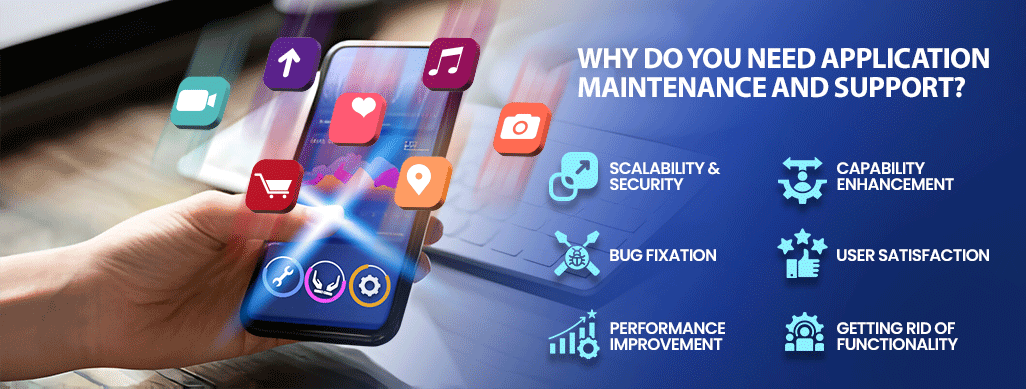
We use cookies to ensure that we give you the best experience on our website.
By using this site, you agree to our use of cookies. Find out more.
This blog post will discuss what application maintenance and support entail, why they are important for business productivity and the key areas they can help with including bug fixation, capability enhancement, getting rid of outdated functionalities, performance improvement and ensuring scalability and security.

As we move into the new year 2024, it is important for businesses to maximize productivity and efficiency. One way to achieve this is by focusing on application maintenance and support. The software and tools businesses rely on to function need regular upkeep and improvements to continue running smoothly. Without proper maintenance and support, applications can start to experience bugs, security vulnerabilities, decreased performance and become outdated. To get the most value from their existing technology investments, businesses should implement a strategy for application maintenance and support.
This blog post will discuss what application maintenance and support entail, why they are important for business productivity and the key areas they can help with including bug fixation, capability enhancement, getting rid of outdated functionalities, performance improvement and ensuring scalability and security. I will also explore the main activities involved in application maintenance and support such as correction, upgradation, retrieval and enhancement.
An Application support and maintenance in today's context refers to any software or program that is utilized by individuals, teams and organizations to perform tasks and functions related to their work. This could include enterprise resource planning (ERP) applications, customer relationship management (CRM) systems, human resource management (HRMS), accounting and finance software and tailored proprietary applications designed specifically for a company's unique processes.
All such applications require ongoing support and maintenance to ensure they run seamlessly and deliver optimal performance. Application support involves activities like handling user queries, resolving errors or bugs and rolling out minor software upgrades. Maintenance activities relate to keeping the application up-to-date, compliant with new regulations, fixing security vulnerabilities and modifying or enhancing features based on evolving business needs. Timely support and regular maintenance are important for any application to remain useful and effective over its functional lifespan.
Application support and maintenance refers to the ongoing care and enhancements required for software applications to continue functioning optimally and meet business needs over time. As applications are used heavily and technology evolves rapidly, software needs regular updates, upgrades and repairs to address issues, bugs or performance issues before they negatively impact workflows.
Application support and maintenance involves a variety of services like applying patches and security fixes, monitoring performance, resolving bugs or glitches in a timely manner, integrating new features, and compliance with changing technical or legal standards. It also includes helping users get the most value from applications through training and assistance. Not performing proper application support and maintenance can compromise software stability, security and user experience over the long run. It is a critical post-implementation process to maximize return on investment in technology.
Here are some points why do you need application maintenance and support:

One of the primary goals of performing regular application support and maintenance is to address any bugs or defects that come up over time. Even the most well-developed applications can start exhibiting unexpected and unwanted behaviors as they are used increasingly. Minor bugs, if left unresolved, could cascade into bigger issues negatively impacting the overall user experience.
Through application support, users report any errors or glitches experienced. The development and support teams then work to analyze the bugs, replicate them and determine the root cause. Appropriate fixes are developed and tested before being released. Application maintenance plays a big role in bug fixation. The code is regularly monitored and updated to fix bugs preventing potential outages or data losses. Addressing defects in a timely manner ensures the application continues functioning smoothly and as intended. This helps minimize disruptions and enhances user satisfaction levels.
Ensuring the application evolves with changing business needs is another important objective of performing regular maintenance activities. Through application support and maintenance, organizations can continuously enhance the capabilities of their core applications. By gathering feedback from users, the requirements for new features get captured. The development team then works to expand and augment existing functionality. Regular enhancements help improve productivity and keep the application relevant.
For example, new modules may be added to streamline key processes like inventory management or invoicing. The interface could also be enhanced for better user experience. Performing these upgrades under the application support and maintenance plan allows modifications seamlessly without impacting stability. Proper testing is conducted before releases. This helps the application to address emerging demands while receiving the benefits of a well-maintained solution.
As part of the regular application support services, one important maintenance activity is identifying and removing outdated features and functionalities from the core application. Over time, the business needs and processes may change rendering some older modules or screens obsolete. Continuing to carry such legacy elements adds unnecessary complexity while also increasing maintenance overhead. The support team plays a key role here by conducting periodic reviews and taking inputs from end users to tag components that are no longer actively used.
As part of scheduled maintenance releases, the development team removes deprecated items from the codebase. This helps prune away clutter and focus only on the truly essential parts. Streamlining the application by discarding outdated elements enhances efficiency. It also helps re-allocate resources to more priority areas under the application support services like adding new capabilities or performance optimization.
Ensuring optimal performance of critical applications is one of the core objectives of carrying out regular support services. Over periods of increased usage and encoding of additional features, the application response times may degrade if not properly maintained. The support team regularly monitors key performance indicators like load times, processing speeds, memory utilization etc.
Any anomalies or bottlenecks identified are analyzed thoroughly. Where required, optimizations like code refactoring, upgrading outdated dependencies, infrastructure changes are implemented. Through the maintenance release cycles under application support, such performance-related fixes and improvements are deployed.
Testing validates that expected enhancements are achieved. Faster loading pages and screens translate to higher worker productivity. Users also experience improved satisfaction levels. Timely performance tweaks help the application seamlessly cope with growing workload and complexities - maximizing returns on existing technology investments.
Ensuring the application can scale efficiently to evolving business needs while maintaining robust security is an important aspect of regular maintenance activities. As user numbers and data volumes increase over time, the application must be able to scale up its architecture horizontally as well as vertically.
The development team performing maintenance evaluates parameters like hardware requirements, high-availability settings, load-balancing etc to future-proof scalability. Similarly, to address the constantly changing threat landscape, planned upgrades are made to bolster application security - from infrastructure layers to input sanitization. Vulnerability testing helps detect issues that need to be patched.
By systematically monitoring and improving scalability and security under the scheduled Application Support And Maintenance plan, the application remains dependable in supporting business growth without compromising on performance or exposing sensitive data to risks.
Ensuring high levels of user satisfaction is a key goal of any Application Support And Maintenance program. With regular planned maintenance releases and fixes, users enjoy a streamlined experience with fewer glitches overtime. Bugs get addressed swiftly, enhancing reliability of the application. The feedback obtained during support also aids in defining the future roadmap for enhancements. As new modules and features get added, users benefit from an expanded suite of capabilities tailored to their evolving requirements.
An intuitive user interface optimized for different devices further boosts productivity. Training on application updates keeps users knowledgeable. All these efforts translated to increased ease of use. Timely resolution of issues under Application Support And Maintenance services builds user confidence in the reliability of business systems. Higher satisfaction improves adoption and ultimately drives better realization of technology investments.
Here are the key activities involved in application maintenance and support:
Implementing robust Application Support And Maintenance practices can deliver significant benefits to boost productivity for businesses in 2024. From fixing defects proactively to upgrading features, optimized performance to strengthened security, such maintenance ensures existing applications continue functioning as productively as when newly launched. It maximizes return on technology investments by extending the useful life span of applications.
An added advantage is higher user adoption and satisfaction with a reliable, seamless experience. Regular maintenance thus plays a pivotal role for organizations in remaining agile to address changing market needs and capturing new opportunities through their technology investments. Committing to scheduled Application Support And Maintenance should be a top priority as we enter the new year.
Leave a Comment
Your email address will not be published.